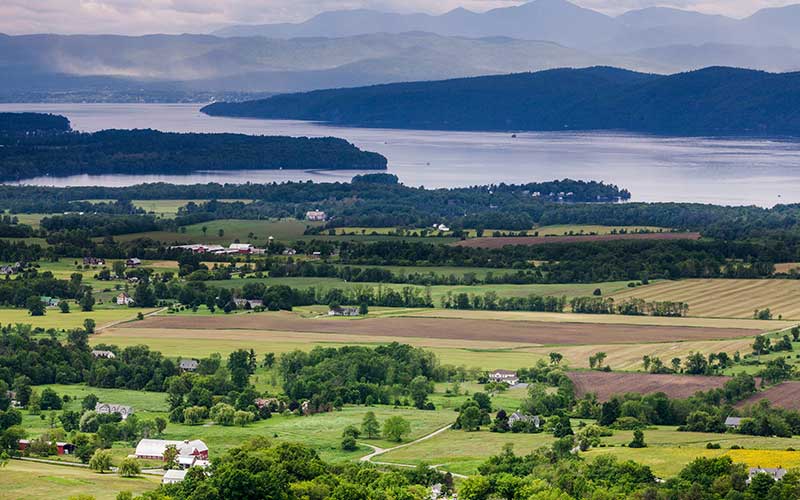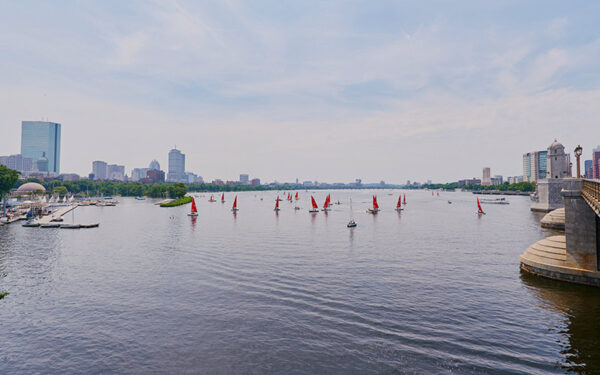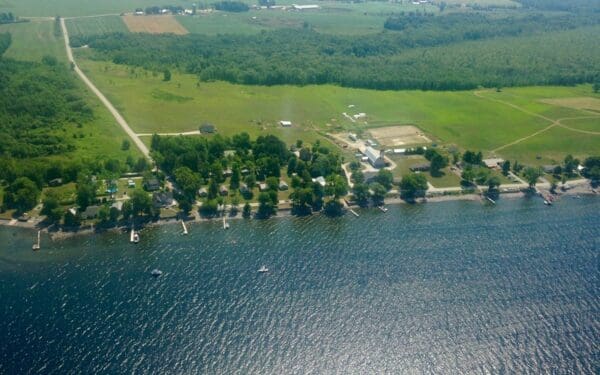
CLF has used the law, policy, and grassroots organizing to push for the clean-up of Lake Champlain. Progress has been frustratingly slow, but the organization is gearing up for yet another push, buoyed by community members, volunteers, and donors who refuse to give up this urgent fight. Photo: Melanie Bishop via Shutterstock
If there’s one thing that most Vermonters can agree on, it’s that Lake Champlain is in trouble. The iconic lake is central to Vermont’s identity and its tourism economy. It provides drinking water and feeds thirsty farms throughout its large watershed.
It’s also dying a slow death due to unchecked pollution.
How to stop that pollution, by when, and how much to spend have been debated for years. As someone who has been on the front lines of the fight for more than two decades, Chris Kilian, who oversaw CLF’s Vermont Advocacy Center before becoming the organization’s Director of Strategic Litigation, has a unique perspective. “The politics of the day and the drivers behind those politics keep changing, which means the will to take action changes, too,” he says. “Unfortunately, the one constant is that the lake is getting worse and worse.”
The main villain in this story is phosphorus, which pours into waterways from sewage treatment plants as well as from farm fields, roads, parking lots, and other watertight surfaces every time it rains or snow melts. Too much phosphorus causes blue-green algae outbreaks, which rob the water of oxygen, killing aquatic life. Those outbreaks are also toxic. They can sicken pets and people, and research now links long-term exposure to the onset of neurological diseases including Lou Gehrig’s and Alzheimer’s.
It’s not news to anyone that phosphorus pollution is killing Lake Champlain. The first study documenting its impact on the lake was published in 1989, the same year CLF opened its Vermont office. But even after the State established water quality standards in 1991, the lake was left to languish. Regulators not only ignored deadlines for setting pollution limits, they repeatedly sought to extend them, far into the future, over CLF’s repeated objections.
When Kilian came to CLF in 1999, it was with the express purpose of making headway on Lake Champlain. CLF had made history 16 years before when it forced what would become the decades-long clean-up of Boston Harbor, but Kilian knew that the Lake Champlain case would be more complex.
“In Boston Harbor, the sources of pollution were virtually all subject to the Clean Water Act,” he says, which made the case more clear-cut, at least concerning legal accountability. “Here in Vermont, 60 percent of the pollution comes from sources like farms that haven’t been regulated effectively by federal law.” Other sources that are regulated, he says, such as stormwater pollution from watertight, paved surfaces, have been shielded by a host of regulatory loopholes. Attempts to close them are met by powerful industry resistance.
Undaunted, Kilian filed more than 20 lawsuits over 10 years. He targeted the State, the Environmental Protection Agency (EPA), and individual polluters, all to force judicial oversight of a comprehensive clean-up plan, like the one CLF had achieved for Boston Harbor. Those lawsuits made significant gains and suffered some setbacks, but still, Lake Champlain was getting worse, and State and federal regulators remained unwilling to take the hard steps necessary to stem the tide of phosphorus into the lake’s fragile waters.
Kilian recognized from the start that it would take more than legal maneuvers to effect meaningful change. CLF would also need to rally the public to push for State-level action. In 2001, CLF established the Lake Champlain Lakekeeper®, with the aim of raising public consciousness about the plight of the lake. Vermonters needed to understand that clean water wasn’t a luxury, but their right. The Lakekeeper worked to educate the public that the status quo was not only killing the lake, but harming people and the economy as well.
By 2008, more Vermonters were waking up to the issues plaguing Lake Champlain, but State action remained at a standstill. So CLF filed one more lawsuit, this time against EPA to force the federal agency to develop more stringent legal limits on phosphorus pollution – limits the State would have to follow. Three years later, EPA agreed. It would take five more years to develop and approve the new limits, but in 2016, the federal agency adopted an ambitious plan that, for example, calls for farms in the Missisquoi Bay area, which feeds into northern Lake Champlain, to cut their phosphorus pollution by 83 percent. Developments need to cut their pollution by more than 20 percent.
At the same time, State agencies finally appeared poised to act as well. By 2016, the legislature had passed an ambitious new bill that codified clean-up of the lake into law and established a slew of new rules for pollution from agriculture, development, and wastewater. While much work remained to be done to ensure full implementation of the new law and rules, Kilian felt cautiously optimistic that this time, after years of sustained effort, Lake Champlain might finally have a chance at recovery.
Then, as had happened so many times before, the political winds shifted. As President Trump swept industry darling Scott Pruitt into the lead role at EPA and a new governor was sworn in at the Vermont State House, Kilian found himself reading from an all-too-familiar playbook. State agencies afraid of controversy began asking for delays in implementing the ambitious new rules passed barely a year before, while others at the State House began seeking legislative strategies to weaken the new clean water law and starve regulators of the funding needed to implement it.
“We are once again trying to hold the line on the progress and promises that have been made while fighting to move clean-up efforts forward,” Kilian says. Meanwhile, the lake’s decline continues. The good news, however, is that the Vermont legislature is so far holding firm, and the new rules remain in effect
It’s frustrating, to be sure, to find oneself back at the start after so many years of effort. So what keeps Kilian and CLF so dedicated to the fight? The volunteers, donors, and community members who urge him on. “They want us to be fighting and keeping these issues high profile,” he says. But CLF can’t do it on its own. “Continued public outrage will be needed to see things change. Legislators and government offices need to hear from people who want to see the lake cleaned up.”
After nearly 20 years, the fight for Lake Champlain has only just begun.



